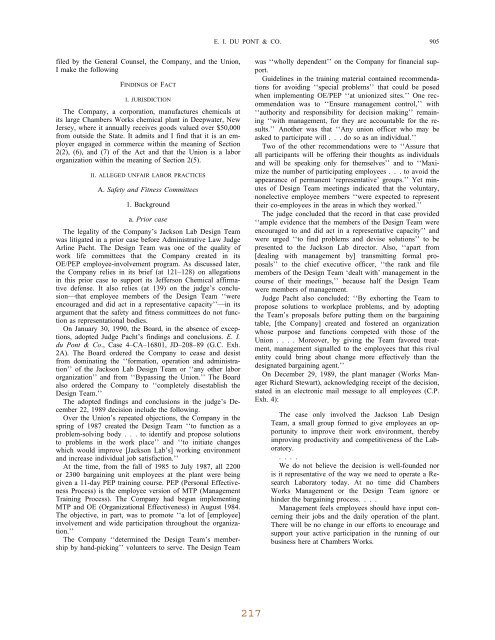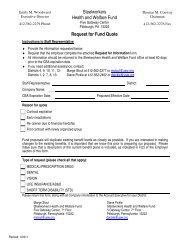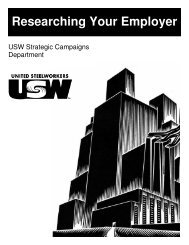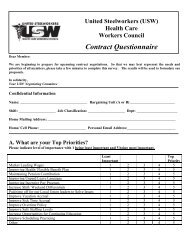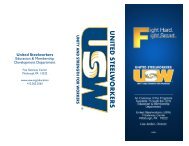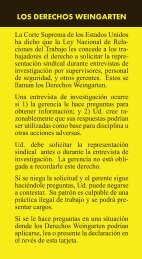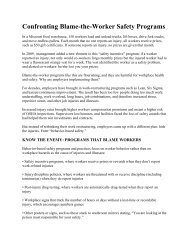Union Approach to Health and Safety: - United Steelworkers
Union Approach to Health and Safety: - United Steelworkers
Union Approach to Health and Safety: - United Steelworkers
Create successful ePaper yourself
Turn your PDF publications into a flip-book with our unique Google optimized e-Paper software.
E. I. DU PONT & CO.<br />
905<br />
filed by the General Counsel, the Company, <strong>and</strong> the <strong>Union</strong>,<br />
I make the following<br />
FINDINGS OF FACT<br />
I. JURISDICTION<br />
The Company, a corporation, manufactures chemicals at<br />
its large Chambers Works chemical plant in Deepwater, New<br />
Jersey, where it annually receives goods valued over $50,000<br />
from outside the State. It admits <strong>and</strong> I find that it is an employer<br />
engaged in commerce within the meaning of Section<br />
2(2), (6), <strong>and</strong> (7) of the Act <strong>and</strong> that the <strong>Union</strong> is a labor<br />
organization within the meaning of Section 2(5).<br />
II. ALLEGED UNFAIR LABOR PRACTICES<br />
A. <strong>Safety</strong> <strong>and</strong> Fitness Committees<br />
1. Background<br />
a. Prior case<br />
The legality of the Company’s Jackson Lab Design Team<br />
was litigated in a prior case before Administrative Law Judge<br />
Arline Pacht. The Design Team was one of the quality of<br />
work life committees that the Company created in its<br />
OE/PEP employee-involvement program. As discussed later,<br />
the Company relies in its brief (at 121–128) on allegations<br />
in this prior case <strong>to</strong> support its Jefferson Chemical affirmative<br />
defense. It also relies (at 139) on the judge’s conclusion—that<br />
employee members of the Design Team ‘‘were<br />
encouraged <strong>and</strong> did act in a representative capacity’’—in its<br />
argument that the safety <strong>and</strong> fitness committees do not function<br />
as representational bodies.<br />
On January 30, 1990, the Board, in the absence of exceptions,<br />
adopted Judge Pacht’s findings <strong>and</strong> conclusions. E. I.<br />
du Pont & Co., Case 4–CA–16801, JD–208–89 (G.C. Exh.<br />
2A). The Board ordered the Company <strong>to</strong> cease <strong>and</strong> desist<br />
from dominating the ‘‘formation, operation <strong>and</strong> administration’’<br />
of the Jackson Lab Design Team or ‘‘any other labor<br />
organization’’ <strong>and</strong> from ‘‘Bypassing the <strong>Union</strong>.’’ The Board<br />
also ordered the Company <strong>to</strong> ‘‘completely disestablish the<br />
Design Team.’’<br />
The adopted findings <strong>and</strong> conclusions in the judge’s December<br />
22, 1989 decision include the following.<br />
Over the <strong>Union</strong>’s repeated objections, the Company in the<br />
spring of 1987 created the Design Team ‘‘<strong>to</strong> function as a<br />
problem-solving body . . . <strong>to</strong> identify <strong>and</strong> propose solutions<br />
<strong>to</strong> problems in the work place’’ <strong>and</strong> ‘‘<strong>to</strong> initiate changes<br />
which would improve [Jackson Lab’s] working environment<br />
<strong>and</strong> increase individual job satisfaction.’’<br />
At the time, from the fall of 1985 <strong>to</strong> July 1987, all 2200<br />
or 2300 bargaining unit employees at the plant were being<br />
given a 11-day PEP training course. PEP (Personal Effectiveness<br />
Process) is the employee version of MTP (Management<br />
Training Process). The Company had begun implementing<br />
MTP <strong>and</strong> OE (Organizational Effectiveness) in August 1984.<br />
The objective, in part, was <strong>to</strong> promote ‘‘a lot of [employee]<br />
involvement <strong>and</strong> wide participation throughout the organization.’’<br />
The Company ‘‘determined the Design Team’s membership<br />
by h<strong>and</strong>-picking’’ volunteers <strong>to</strong> serve. The Design Team<br />
was ‘‘wholly dependent’’ on the Company for financial support.<br />
Guidelines in the training material contained recommendations<br />
for avoiding ‘‘special problems’’ that could be posed<br />
when implementing OE/PEP ‘‘at unionized sites.’’ One recommendation<br />
was <strong>to</strong> ‘‘Ensure management control,’’ with<br />
‘‘authority <strong>and</strong> responsibility for decision making’’ remaining<br />
‘‘with management, for they are accountable for the results.’’<br />
Another was that ‘‘Any union officer who may be<br />
asked <strong>to</strong> participate will . . . do so as an individual.’’<br />
Two of the other recommendations were <strong>to</strong> ‘‘Assure that<br />
all participants will be offering their thoughts as individuals<br />
<strong>and</strong> will be speaking only for themselves’’ <strong>and</strong> <strong>to</strong> ‘‘Maximize<br />
the number of participating employees . . . <strong>to</strong> avoid the<br />
appearance of permanent ‘representative’ groups.’’ Yet minutes<br />
of Design Team meetings indicated that the voluntary,<br />
nonelective employee members ‘‘were expected <strong>to</strong> represent<br />
their co-employees in the areas in which they worked.’’<br />
The judge concluded that the record in that case provided<br />
‘‘ample evidence that the members of the Design Team were<br />
encouraged <strong>to</strong> <strong>and</strong> did act in a representative capacity’’ <strong>and</strong><br />
were urged ‘‘<strong>to</strong> find problems <strong>and</strong> devise solutions’’ <strong>to</strong> be<br />
presented <strong>to</strong> the Jackson Lab direc<strong>to</strong>r. Also, ‘‘apart from<br />
[dealing with management by] transmitting formal proposals’’<br />
<strong>to</strong> the chief executive officer, ‘‘the rank <strong>and</strong> file<br />
members of the Design Team ‘dealt with’ management in the<br />
course of their meetings,’’ because half the Design Team<br />
were members of management.<br />
Judge Pacht also concluded: ‘‘By exhorting the Team <strong>to</strong><br />
propose solutions <strong>to</strong> workplace problems, <strong>and</strong> by adopting<br />
the Team’s proposals before putting them on the bargaining<br />
table, [the Company] created <strong>and</strong> fostered an organization<br />
whose purpose <strong>and</strong> functions competed with those of the<br />
<strong>Union</strong> . ... Moreover, by giving the Team favored treatment,<br />
management signalled <strong>to</strong> the employees that this rival<br />
entity could bring about change more effectively than the<br />
designated bargaining agent.’’<br />
On December 29, 1989, the plant manager (Works Manager<br />
Richard Stewart), acknowledging receipt of the decision,<br />
stated in an electronic mail message <strong>to</strong> all employees (C.P.<br />
Exh. 4):<br />
The case only involved the Jackson Lab Design<br />
Team, a small group formed <strong>to</strong> give employees an opportunity<br />
<strong>to</strong> improve their work environment, thereby<br />
improving productivity <strong>and</strong> competitiveness of the Labora<strong>to</strong>ry.<br />
....<br />
We do not believe the decision is well-founded nor<br />
is it representative of the way we need <strong>to</strong> operate a Research<br />
Labora<strong>to</strong>ry <strong>to</strong>day. At no time did Chambers<br />
Works Management or the Design Team ignore or<br />
hinder the bargaining process. ...<br />
Management feels employees should have input concerning<br />
their jobs <strong>and</strong> the daily operation of the plant.<br />
There will be no change in our efforts <strong>to</strong> encourage <strong>and</strong><br />
support your active participation in the running of our<br />
business here at Chambers Works.


